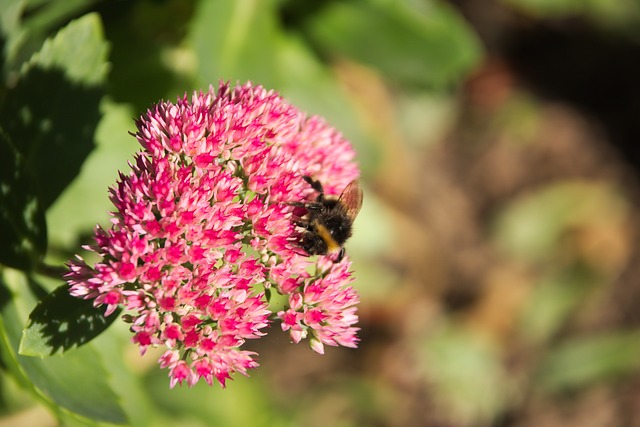 |  |  |   |   |
  |  |
Perennial succulent from the thick-leaved family. The roots are expanded in a rubbery manner. Stems are simple, 20-70 cm tall, thickly covered. The leaves are arranged alternately, elongated, fleshy, glabrous with plaque. The lower ones are narrowed, in short petioles, the upper leaves are sessile, with a round base. The flowers are small, with 5 petals, pink, purple or almost white, arranged in a dense shield-like bract at the top of the stem. Fruit someni. Blooms in July-August.
Orpine is a medicinal plant. The fresh plant is most often used for treatment. The plant begins to be harvested during its flowering period, which began in July and ends in October. The fruits ripen in autumn.
Orpine are harvested in dry weather. It is recommended in the early hours of the morning, as soon as the dew dries from the leaves. The rhizomes are left in the soil and can be harvested in autumn (September-October). The rhizomes are further washed, cut into pieces and dried.
The leaves of Orpine are dried in the fresh air, in a shaded and well-ventilated place. The attic is very useful for this purpose.
It is good to know that when you collect the Orpine , and dry them, they will continue to grow and the buds will open and the plant will continue to bloom. It often has a bad effect on the quality of the drug.
Before drying the plant, it is recommended to chop it, after chopping it can be washed, before drying the plant is processed in a forced dryer or oven, not exceeding 60C. A properly dried drug will have a pronounced, specific aroma, the leaves are stored for 2 years, the rhizomes for 3 years.
There are carbohydrates (glucose, fructose, sucrose, sedoheptulose), 6% organic acids (oxalic acid, citric acid, malic acid, succinic acid, fumaric acid, glycolitic acid), vitamin C, phenols and their derivatives (arbutin), phenolic acids (gallic acid), coumarins (coumarin, esculetin), tannins, flavonoids (kaempferol, quercetin, isoquercitrin, kaempferitrin, 7-glycoside and 3,7-dyrhamnosyl glycoside kaempferol, 3,7-dyrhamnosyl glycoside quercetin), triterpene saponins, alkaloids, phenols and their derivatives (arbutin), as well as tanning substances.Medicinal significance
The plant is useful as a source of tissue preparations - biogenic stimulators, whose activity exceeds that of aloe vera. Decoctions and decoctions are used to treat arrhythmia, tachycardia, arthralgia, osteoalgia, metabolic disorders, menoralgia, infertility and chronic rheumatism.
Fresh juice or decoction is used externally as a hemostatic, wound-healing agent. The juice and extract stimulate the CNS.
A decoction of the gummy root of Orpine is taken orally to treat impotence and epilepsy, and externally to treat wounds, burns, blisters and warts. Root juice is used as a wound healing, anti-scurvy and anti-helminthic agent.
In Tibet, decoctions and infusions are used to treat pulmonary tuberculosis, pneumonia, kidney disease, anorexia, and are also used to heal wounds and as a diuretic.
In folk medicine, a decoction of Orpine is used as a tonic, anti-inflammatory agent, it is used to treat malignant neoplasms, asthenia, scurvy, diarrhea, helminthosis, ascites, anemia, bladder stone disease, heart failure, kidney and bladder diseases, gonorrhea, fever and colds; externally (decoctions on water or milk) are used in case of arthritis, rheumatism, gout.
The juice or plant extract is used for the treatment of intestinal tract diseases and epilepsy; externally, to treat stomatitis, thrush in young children, burns, to accelerate the granulation of non-healing wounds, to treat malignant neoplasms, panarichia, paronychia. As well as to get rid of warts and blisters.
Decoctions of Orpine are drunk to increase potency, to treat tuberculosis, scurvy, ascites, rheumatism, jaundice, malaria, kidney diseases, epilepsy, nervous diseases, eczema, and are used as a laxative and diuretic. Externally, to heal skin ulcers, carbuncles, canker sores, skin eruptions, paronychia and hemorrhoids.
The juice of the Orpine has anti-bleeding and wound-healing properties. Thanks to the chemical composition of the plant, the juice of the plant improves the metabolism, which also promotes the regeneration of damaged tissues.
Orpine is capable of strengthening immunity, normalizes the functioning of the cardiovascular system. In addition, the functioning of the internal organs improves.
Gynecological diseases (fibroids, cysts, infertility) are also treated with the plant. Men treat prostatitis with it, and it also increases potency.
